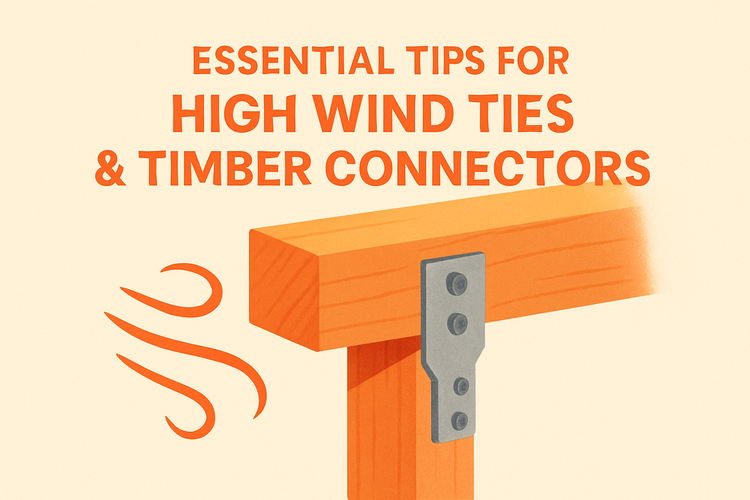Essential Tips For High Wind Ties & Timber Connectors For Builders

Understanding the Importance of High Wind Ties
High wind ties are critical for safeguarding structures against uplift and lateral forces caused by strong winds. These connectors provide reinforcement in key framing joints, improving resilience in wind-prone areas.
In regions where hurricanes or storm-force winds are common, using high wind ties during construction ensures that the structural frame remains locked together, reducing the risk of significant damage. Builders should integrate these components at every major joint — particularly roof-to-wall and wall-to-foundation sections — to create a continuous load path.
Failing to include proper uplift connections not only compromises safety but may also void insurance or building code compliance. These connectors are commonly made from galvanized or stainless steel for long-term durability and corrosion resistance in varied climates.
Choosing the Right Timber Connectors for Wind Resistance
Not all timber connectors are suitable for high wind applications, so choice matters. Selecting the right products based on wind load calculations and timber species ensures long-term performance.
Builders must assess factors such as load rating, ease of installation, and compatibility with treatment chemicals in timber. For example, Connectors for Glulam Timber provide enhanced grip and strength in engineered wood beams used in structural frames exposed to high wind pressure. Similarly, Connectors for Cross Laminated Timber offer stability in large panel systems commonly used in modern eco-construction, ensuring panels remain stable under upward forces.
Alternate options like angle brackets and joist hangers can be reinforced with screws or bolts to expand their load-bearing capacity. High-strength screws or ring-shanked nails are often necessary to complement the strength of heavy-duty timber connectors in storm-ready builds.
Best Practices in High Wind Construction
Installation quality is just as important as the hardware. Poorly fixed connectors can fail even if the product itself is rated for high loads.
Builders should always follow manufacturer installation guidelines, which specify fastener types, edge distance, and placement for optimal strength. Using incorrect fixings or overdriving can reduce the performance of connectors significantly. In timber structures, proper alignment and secure fixing ensure that the load path remains unbroken from the roof down to the foundation.
In wall and roof junctions, consider layering multiple connector types to increase joint redundancy. For example, combining Joist Hangers with restraint straps can prevent both downward pulling and lateral shifting forces common in strong gales.
Weatherproofing also contributes to performance. Moisture intrusion can compromise timber and reduce the grip of fixings. Applying protective coatings or selecting galvanized hardware minimizes rust and degradation over time, ensuring the wind ties maintain their rated strength.
Common Mistakes to Avoid
Even experienced builders can overlook key principles when working under time pressure or when attempting to reduce material costs.
One frequent issue is underestimating wind loads, especially in areas with rapidly changing conditions. This often results in under-specifying the grade or size of high wind ties. Another error is not providing enough edge clearance or using incompatible fasteners, leading to timber splitting or weakened hold. Avoid these oversights by cross-checking specifications and investing in proper training for site workers.
A lack of coordination between architecture and structural engineering teams can also be problematic. Design details must reflect realistic environmental conditions, and the layout of the timber frame should accommodate the strategic placement of High Wind Ties & Timber Connectors.
Routine inspections during and after installation can catch mistakes before structural loads are applied. Damaged or rusted components should always be replaced, not repaired or reused, for safety assurance in high-stress environments.
Strengthening Structures Beyond Wind Ties
While wind ties play a crucial role, combining them with other structural connectors ensures maximum integrity.
For instance, Restraint Straps help anchor upper floors or gable ends to lower sections, reducing deflection or twisting under wind pressure. These are especially useful in timber frame buildings, which can naturally flex under load. Proper integration of multiple connector types also helps distribute forces more evenly throughout the structure and reduces stress at any single point.
In addition, using robust foundation connections like Post Bases helps stabilize vertical load-bearing members. When the base is securely fixed to a concrete footing, uplift is managed more effectively. When used with wind ties at higher junctions, this creates a reliable tie-down framework from top to bottom of a structure.
Ultimately, strong design combined with comprehensive hardware planning is the key to resilience in high wind construction. Properly chosen and placed connectors not only prevent collapse but can also significantly reduce repair costs after intense storms. Builders looking to enhance structural safety should view wind ties as part of a greater connective strategy across their entire framework.
